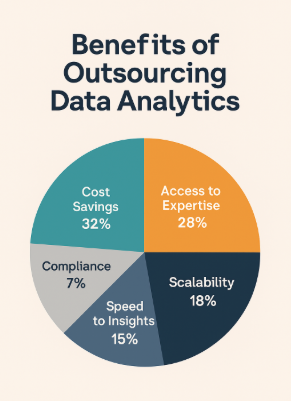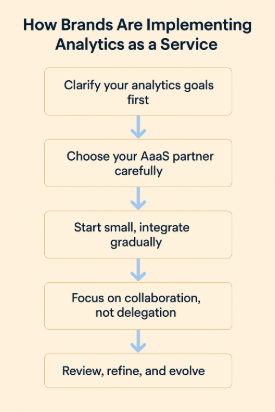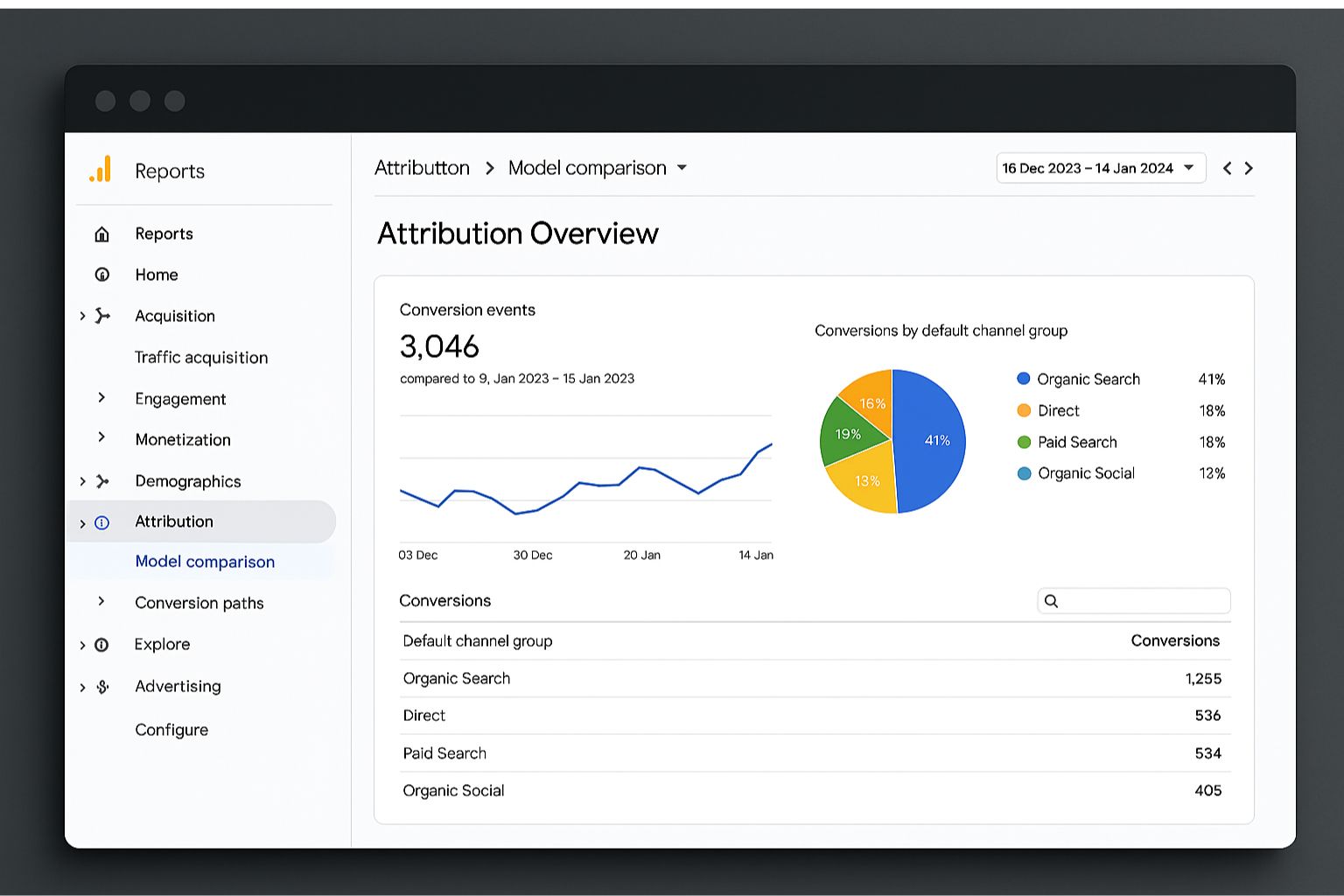
Every brand is swimming in data, but very few are turning it into real decisions.
Over the past few years, marketing teams have built dashboards, stitched platforms together, and hired analysts… Yet most still say the same thing: “We have the data, but we don’t trust it.”
That’s exactly where Analytics as a Service (AaaS) is starting to change the game. Instead of building expensive in-house teams or juggling half-connected tools, more companies are outsourcing their analytics operations to specialized partners who handle everything from data collection to visualization.
By 2026, this shift isn’t just a trend, it’s becoming a necessity. As data grows faster than most teams can manage, AaaS is emerging as the smarter way for brands to scale analytics without losing clarity or control.
In this post, we’ll unpack why outsourcing data analytics is gaining traction, how AaaS models work, and what forward-thinking brands are doing to stay ahead of the curve.
What Is Analytics as a Service (AaaS)?
Most companies collect more data than they’ll ever use. It sits in dashboards, CRMs, spreadsheets, ad platforms, everywhere, and no one really knows which numbers to trust. I’ve seen teams spend months setting up “the perfect” tracking system, only to realize half their data is missing or duplicated.
That’s usually when someone brings up Analytics as a Service, or just AaaS.
It’s a fancy term, but the idea is simple: instead of building everything yourself, you let a team that lives and breathes analytics handle the hard part. They manage the tools, the integrations, the cleanup, the dashboards, all the behind-the-scenes work that most marketing teams don’t have time (or patience) for.
You still keep full control of your data. The difference is that someone else keeps it organized and makes sure you can actually use it. Everything runs through cloud platforms like Google Cloud or AWS, so it scales easily and doesn’t need internal IT support every time something breaks.
And honestly, that’s the big appeal. AaaS isn’t about losing control; it’s about finally getting clarity. You get to focus on decisions, not dashboards.
Key Features of AaaS
- Cloud-based setup: No servers to maintain, no infrastructure nightmares. It scales automatically as your business grows.
- Real-time dashboards: Forget static monthly reports. You can see campaign data update live and spot issues before they snowball.
- AI-powered insights: Instead of staring at numbers, you get short, meaningful takeaways, what’s up, what’s down, and why it matters.
- End-to-end coverage: From tracking tags to reports, everything is handled under one roof, which means less noise and more consistency.
How AaaS Works
Here’s the short version.
AaaS connects all your data sources, ad platforms, CRMs, websites, email, then cleans and structures the data automatically. After that, everything’s visualized in dashboards your team can actually understand.
If you’ve ever dealt with tracking chaos, this model feels like a relief. No more waiting on reports or chasing missing conversions. The insights are just there, ready when you need them.That’s why analytics outsourcing is taking off so quickly in 2026. Teams are realizing it’s not about outsourcing responsibility, it’s about getting back time and accuracy.
Why Are More Brands Outsourcing Their Data?

Most companies don’t decide to outsource analytics because it sounds trendy, they do it because keeping it in-house has become too complicated. The amount of data being created, especially across marketing, sales, and product tools, has exploded. For many teams, managing that volume feels like bailing water from a sinking boat.
In 2026, the move toward data analytics outsourcing has a few clear drivers. Let’s look at the big ones.
1. Cost and efficiency
Hiring analysts, engineers, and data leads isn’t cheap. Maintaining a full analytics setup, servers, software, people eats up both budget and time. With Analytics as a Service (AaaS), you pay only for what you use. Brands get the same depth of analysis without the overhead. For most, that’s the first reason to outsource analytics.
2. Access to real expertise
Good analysts are hard to find. Great ones are even harder to keep. Outsourcing gives companies direct access to professionals who do this work all day, across multiple industries. They bring battle-tested setups, faster onboarding, and a level of accuracy that’s tough to build internally. This access to analytics expertise is one of the main benefits of AaaS.
3. Faster, cleaner insights
In-house teams often spend weeks cleaning data before they can even start analyzing it. AaaS providers automate most of that process, delivering speed of insights that keeps decision-makers moving. In a market where timing defines success, that matters more than ever.
4. Scalability and flexibility
Business growth usually means new tools, new data sources, and new headaches. Cloud-based analytics models scale automatically, handling growth without manual setup. It’s one of the main cloud analytics adoption trends driving this shift, scale without infrastructure strain.
Learn more about improving tracking accuracy in our post on GA4 attribution insights.
5. Compliance and data security
With privacy laws tightening and tracking getting more complex, brands can’t afford mistakes. AaaS providers bake in compliance from the start, following frameworks like GDPR and CCPA. Outsourcing analytics to a team that understands those rules lowers risk while keeping reporting consistent.
The bigger story here is that in-house analytics hasn’t failed, it’s just stretched to the limit. As AI becomes a standard part of every platform, AI in analytics and automated monitoring make outsourced models faster, safer, and more reliable than ever. For many brands, 2026 is the year they stop fighting with data and start letting specialists handle it.
For a closer look at how AI is reshaping digital visibility, check out our post on AI-driven search and analytics evolution.
How Brands Are Implementing Analytics as a Service

When companies first hear about Analytics as a Service (AaaS), it sounds simple, hand off your data, get better insights. In reality, implementing AaaS takes a bit more thought. The payoff is huge, but only if it’s done right.
Over the past year, a lot of brands have started this transition. Here’s what that process usually looks like when it actually works.
1. Clarify your analytics goals first
Before you bring in a provider, know what you want out of your data. Are you trying to improve attribution? Clean up tracking? Build real-time dashboards?
The brands that succeed with AaaS walk in with specific questions to answer, not just a general “we need better reporting.” That clarity shapes the whole setup and helps the provider design a solution that fits, not just a plug-and-play system.
2. Choose your AaaS partner carefully
Selecting the right provider is the make-or-break step. There are plenty of vendors who promise AI-driven dashboards, but not all of them understand marketing data, privacy rules, or how to blend multiple systems cleanly.
When you evaluate vendors, look beyond the demo. Ask how they manage data security, how often their pipelines update, and how transparent they are about their process. The best AaaS providers don’t hide behind automation, they explain how your data flows and who’s monitoring it.
3. Start small, integrate gradually
The smartest teams don’t rip out everything on day one. They start with one part of their data, usually marketing and CRM, and expand once the foundation is stable.
During implementation, your provider will connect your existing tools, set up cloud pipelines, and build dashboards tailored to your workflows. Expect a few bumps early on; it’s normal. The key is communication, weekly check-ins between your team and theirs make everything move faster.
4. Focus on collaboration, not delegation
AaaS isn’t about handing off responsibility and walking away. It works best when internal teams stay involved, reviewing reports, asking questions, and giving feedback.
The most successful brands treat their AaaS providers like an extension of their data team. That collaboration builds context, the human layer that AI can’t replicate.
5. Review, refine, and evolve
Once AaaS is running smoothly, make time to review performance every quarter. What’s working? What feels clunky? Are the insights actually leading to better decisions?
Top-performing companies treat analytics outsourcing as an ongoing partnership, not a set-and-forget project. They refine dashboards, tweak metrics, and keep their providers aligned with changing business goals.
A quick example:
A retail brand we worked with had five disconnected reporting tools and no clear view of customer behavior. After moving to an AaaS model, they consolidated everything into one real-time dashboard. Within a month, they identified a 15% drop-off in mobile conversions, something they’d been missing for months, and fixed it. That’s the kind of clarity this model brings when implemented well.
Outcomes and Business Impact
When Analytics as a Service (AaaS) works the way it should, you feel it almost immediately. Reports start making sense. Meetings get shorter. Decisions stop dragging on because the numbers finally line up.
Most companies that move to AaaS see the same pattern: faster decisions, leaner operations, and a noticeable lift in marketing performance. It’s not just about better dashboards — it’s about making sense of what used to feel random.
A few examples from brands that made the switch:
- Speed: One ecommerce client cut their weekly reporting time from two days to a few hours. With live dashboards, they stopped waiting for “end-of-month” numbers and started adjusting campaigns in real time.
- Revenue: A SaaS company noticed a 22% jump in upsells within the first quarter after outsourcing analytics. They finally had visibility into which features were driving renewals and could focus on what mattered.
- Efficiency: Another team reduced analytics costs by nearly 30% after retiring a patchwork of third-party tools. Their AaaS setup handled tagging, tracking, and visualization in one ecosystem.
These results aren’t outliers, they’re what happens when clean data meets consistent interpretation. The business benefits of AaaS reach beyond marketing: finance gets more accurate forecasting, operations spot inefficiencies faster, and leadership gains a single source of truth.
The ROI of data outsourcing doesn’t just show up in dollars saved; it’s in the time, confidence, and clarity that teams regain. When everyone trusts the same data, collaboration improves and decisions happen faster.
At the heart of it all is better decision-making. With unified, near-real-time analytics, brands finally get to run strategy based on evidence, not instinct or outdated reports. That’s what makes AaaS more than a service model; it’s a cultural shift in how modern businesses operate.
Future Trends in Analytics as a Service
If the last few years were about collecting data, the next few will be about making it work harder. The way brands use Analytics as a Service (AaaS) is already shifting, and it’s not slowing down.
One of the biggest cloud analytics trends for 2026 is the deeper use of AI inside analytics itself. Not just surface-level dashboards or auto-generated insights, but AI models that actually understand business context. Think predictive forecasting that adjusts in real time, or anomaly detection that flags issues before your team even spots them. That’s where the next wave of AI analytics trends is heading.
Another big change coming is how AaaS providers handle data integration. Right now, most focus on marketing and sales data, but the future will blend product, customer support, and financial metrics into a single, connected layer. When that happens, the line between “analytics team” and “business operations” will practically disappear.
We’ll also see more brands taking a modular approach, mixing and matching AaaS partners for different needs. One for marketing attribution, another for predictive modeling, another for compliance and security. This model gives flexibility while keeping costs predictable.
And of course, the future of analytics outsourcing will keep leaning on privacy-first design. As regulations evolve, analytics platforms will have to build consent, data ownership, and transparency directly into their systems, not bolt them on later. The companies that get that right will lead the next chapter of this space.
For brands, the takeaway is simple: treat analytics as a living system, not a one-time project. Keep your data strategy open, stay close to emerging AaaS models, and experiment early. The goal isn’t to chase every new technology, it’s to stay adaptable enough to use the ones that actually matter.
The next era of analytics won’t belong to the biggest teams. It’ll belong to the ones that move fastest.
Conclusion
By now, it’s clear that Analytics as a Service (AaaS) isn’t just another buzzword, it’s the direction analytics is moving in 2026. The combination of cloud technology, automation, and expert management has made it easier for brands to stay focused on decisions instead of data maintenance.
For many teams, the real data outsourcing benefits come down to clarity and speed. When your analytics runs smoothly in the background, your people can move faster and trust the numbers guiding them. It’s not about giving up control, it’s about gaining more of it where it counts.
If you’re still managing fragmented reports or wrestling with disconnected dashboards, now’s a good time to pause and take stock of your setup. Ask yourself: does your current system make it easier to see what’s working, or harder?
At Y77, we help brands build analytics foundations that are ready for the AI-driven search and reporting world ahead. Whether you’re exploring a full AaaS model or just looking to clean up what you already have, our team can guide you through it, step by step.👉 Let’s talk about how your analytics can do more for you in 2026.
FAQs
Yes. Reputable AaaS providers follow strict compliance frameworks such as GDPR and CCPA. They build security and data governance into their systems, ensuring sensitive customer information is handled safely across all platforms.
Brands are outsourcing because data volume and complexity have grown beyond what internal teams can handle efficiently. AaaS provides access to expert analysts, automated data pipelines, AI-powered dashboards, and lower operational costs, all while ensuring data compliance.
Absolutely. AaaS is scalable, so even smaller businesses can start with a focused analytics setup—like marketing and CRM tracking, and expand over time without investing in new infrastructure or hiring large teams.
AI is enhancing AaaS through predictive forecasting, automated anomaly detection, and personalized insights. These tools help brands anticipate trends, detect performance issues early, and optimize campaigns with minimal manual effort.
Choose providers with strong expertise in marketing analytics, transparent data management practices, real-time reporting, and proven compliance credentials. The right partner should act as an extension of your data team, not just a vendor.

